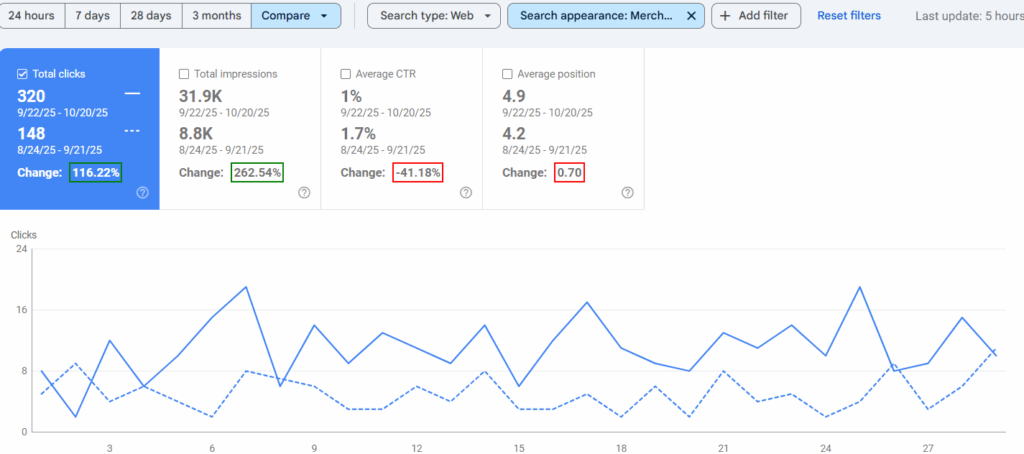Table of Contents
Product Feed SEO Is No Longer Optional
If you run an ecommerce business and you’re not actively optimizing your Google Merchant Center (GMC) feed, you’re leaving clicks and customers on the table.
At Uproer, we’ve seen how a well-structured and strategically optimized GMC feed can drive meaningful organic traffic growth. Especially in competitive industries like health and wellness, kitchenware, and fashion.
The key insight? These results didn’t come from full rebuilds or weeks of development work. They came from focused, feed-level optimizations that helped Google better understand and reward our clients’ products.
In this article, we’ll share how three ecommerce brands achieved:
- A 130% increase in clicks in the health supplements space
- A 116% lift for a fashion brand in just 28 days
- And 3,500 additional clicks for a bakeware client that treated its feed as a core SEO asset
The Challenges Facing Ecommerce Brands
If you manage an ecommerce site, these issues probably sound familiar:
- Organic visibility is shrinking as SERPs become more ad-heavy and AI-generated results occupy more real estate and push traditional listings further down page 1.
- Ownership of the product feed is unclear. Paid search, development, and SEO teams each assume someone else is managing it.
- Your catalog is massive, and optimizing thousands of SKUs for SEO feels impossible.
Each of the brands below faced these challenges in different ways. What they shared was an untapped SEO opportunity hiding in plain sight; their Google Merchant Center feed.
1. Kitchen and Bakeware Brand: Driving Visibility Through Better Keyword Targeting
Refining Titles to Match Real Search Behavior
This client had a strong product catalog, but their listings rarely appeared in the “Popular Products” or “More Products” grids; particularly for long-tail, high-intent queries.
We found an opportunity to connect their feed more closely to real search language. We:
- Updated product titles and descriptions to reflect how users actually searched
- Included size and dimensions directly in product titles
- Used the product_detail attribute to qualify for Google’s “faceted filters” like “nonstick” and “dishwasher safe”
Optimizing for Google’s filters didn’t just improve rankings; it opened visibility in entirely new shopping surfaces.
The Result
Within three months, the brand earned 3,500 incremental clicks from organic GMC listings year over year. These gains came primarily from high-intent, non-branded queries that had previously been missed.

2. Health and Wellness Brand: Navigating Policy Restrictions to Unlock Visibility
Compliance Meets Keyword Strategy
In the supplements category, Google Merchant Center policy violations are common and costly. Many of this client’s best-selling products were disapproved, cutting off visibility in free listings.
We addressed this from two angles:
- Built out more comprehensive product descriptions that matched user intent (Brands can utilize up to 5,000 characters in product feed descriptions).
- Cleaned up product descriptions by removing vague or promotional claims and replacing them with factual, compliant copy
- Optimized category-level titles to bring primary and secondary keywords into feed titles naturally, without sounding spammy
Thinking about compliance as an SEO strategy was the difference between disapproval and discovery.
The Result
Within three months:
- Clicks from free GMC listings increased by 130%
- The brand gained stronger placement in Popular Product grids, even within competitive supplement categories

3. Fashion and Footwear Brand: Building Agility with a Better Feed Management Tool
From Static Feeds to Test-and-Learn Flexibility
This Shopify brand had been relying on the built-in Google and YouTube feed app, which limited their ability to test and customize.
We migrated them to Simprosys, a third-party feed management tool that provided:
- Attribute-level customization
- Rapid A/B testing for title formats
- Full control over optional attributes such as color, gender, and age group
These “optional” attributes are critical for apparel brands. Without them, products can be excluded from free listings altogether.
The Result
Just 28 days after optimization:
- Clicks increased 116%
- Impressions rose 263%
- The brand now operates with a test-and-learn framework for ongoing feed improvements

Don’t Let Your Product Feed Hold You Back
Google’s shopping surfaces are evolving quickly, and product feeds are no longer just a paid media concern. With recent studies showing that ‘Popular Product’ grids appear in more than 80 percent of ecommerce SERPs, your GMC feed has become one of the most influential SEO levers available.
Each of these brands faced different challenges, but their success shared a common mindset: Your product feed is a core SEO asset. It deserves the same strategic attention as your metadata or site structure.
Want to win more visibility from Google’s product grids?
If your feed isn’t delivering the visibility you expect, our team can help. Book an intro with Uproer to learn how feed-first SEO strategies can unlock real growth for your ecommerce brand.

